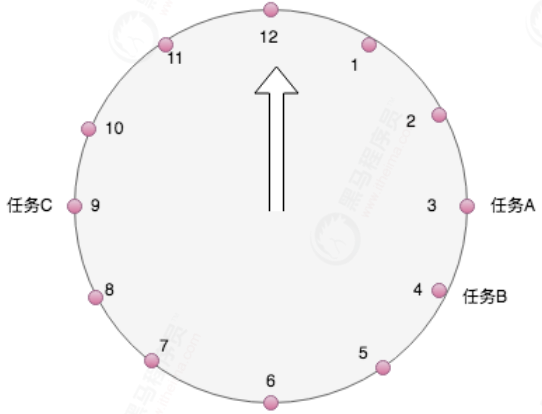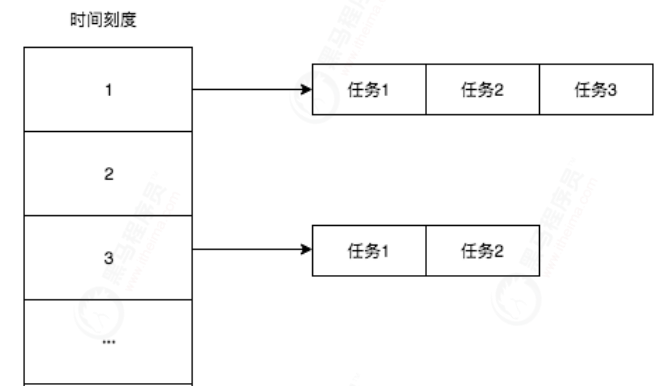一、定时算法 概述
系统或者项目中难免会遇到各种需要自动去执行的任务,实现这些任务的手段也多种多样,如操作系统的crontab,spring框架的quartz,java的Timer和ScheduledThreadPool都是定时任务中的典型手段。
二、最小堆算法
1、概述
Timer是java中最典型的基于优先级队列+最小堆实现的定时器,内部维护一个存放定时任务的优先级队列,该优先级队列使用了最小堆排序。
当我们调用schedule方法的时候,一个新的任务被加入queue,堆重排,始终保持堆顶是执行时间最小(即最近马上要执行)的。同时,内部相当于起了一个线程不断扫描队列,从队列中依次获取堆顶元素执行,任务得到调度。
2、Java实现最小堆算法
下面以Timer为例,介绍优先级队列+最小堆算法的实现原理:
(1)Timer使用
// 基本使用
import java.util.Timer;
import java.util.TimerTask;
class Task extends TimerTask {
@Override
public void run() {
System.out.println("running...");
}
}
public class TimerDemo {
public static void main(String[] args) {
Timer t=new Timer();
//在1秒后执行,以后每2秒跑一次
t.schedule(new Task(), 1000,2000);
}
}
(2)源码分析
t.schedule最终会调用TaskQueue的add方法,新加任务时,t.schedule方法会add到队列:
// java.util.Timer#schedule(java.util.TimerTask, long, long)
public void schedule(TimerTask task, long delay, long period) {
if (delay < 0)
throw new IllegalArgumentException("Negative delay.");
if (period <= 0)
throw new IllegalArgumentException("Non-positive period.");
sched(task, System.currentTimeMillis()+delay, -period);
}
// java.util.Timer#sched
private void sched(TimerTask task, long time, long period) {
if (time < 0)
throw new IllegalArgumentException("Illegal execution time.");
// Constrain value of period sufficiently to prevent numeric
// overflow while still being effectively infinitely large.
if (Math.abs(period) > (Long.MAX_VALUE >> 1))
period >>= 1;
synchronized(queue) {
if (!thread.newTasksMayBeScheduled)
throw new IllegalStateException("Timer already cancelled.");
synchronized(task.lock) {
if (task.state != TimerTask.VIRGIN)
throw new IllegalStateException(
"Task already scheduled or cancelled");
task.nextExecutionTime = time;
task.period = period;
task.state = TimerTask.SCHEDULED;
}
queue.add(task);
if (queue.getMin() == task)
queue.notify();
}
}
// java.util.TaskQueue#add
void add(TimerTask task) {
// Grow backing store if necessary
if (size + 1 == queue.length)
queue = Arrays.copyOf(queue, 2*queue.length);
queue[++size] = task;
fixUp(size);
}
add实现了容量维护,不足时扩容,同时将新任务追加到队列队尾,触发堆排序,始终保持堆顶元素最小:
// java.util.TaskQueue#fixUp
//最小堆排序
private void fixUp(int k) {
while (k > 1) {
//k指针指向当前新加入的节点,也就是队列的末尾节点,j为其父节点
int j = k >> 1;
//如果新加入的执行时间比父节点晚,那不需要动
if (queue[j].nextExecutionTime <= queue[k].nextExecutionTime)
break;
//如果大于其父节点,父子交换
TimerTask tmp = queue[j]; queue[j] = queue[k]; queue[k] = tmp;
//交换后,当前指针继续指向新加入的节点,继续循环,知道堆重排合格
k = j;
}
}
线程调度中的run,主要调用内部mainLoop()方法,使用while循环:
// java.util.TimerThread#mainLoop
private void mainLoop() {
while (true) {
try {
TimerTask task;
boolean taskFired;
synchronized(queue) {
// Wait for queue to become non-empty
while (queue.isEmpty() && newTasksMayBeScheduled)
queue.wait();
if (queue.isEmpty())
break; // Queue is empty and will forever remain; die
// Queue nonempty; look at first evt and do the right thing
long currentTime, executionTime;
task = queue.getMin();
synchronized(task.lock) {
if (task.state == TimerTask.CANCELLED) {
queue.removeMin();
continue; // No action required, poll queue again
}
// 当前时间
currentTime = System.currentTimeMillis();
//要执行的时间
executionTime = task.nextExecutionTime;
//判断是否到了执行时间
if (taskFired = (executionTime<=currentTime)) {
//判断下一次执行时间,单次的执行完移除
//循环的修改下次执行时间
if (task.period == 0) {
// Non-repeating, remove
queue.removeMin();
task.state = TimerTask.EXECUTED;
} else {
// Repeating task, reschedule
//下次时间的计算有两种策略
//1.period是负数,那下一次的执行时间就是当前时间‐period
//2.period是正数,那下一次就是该任务本次的执行时间+period
//注意!这两种策略大不相同。因为Timer是单线程的
//如果是1,那么currentTime是当前时间,就受任务执行长短影响
//如果是2,那么executionTime是绝对时间戳,与任务长短无关
queue.rescheduleMin(
task.period<0 ? currentTime - task.period
: executionTime + task.period);
}
}
}
//不到执行时间,等待
if (!taskFired) // Task hasn't yet fired; wait
queue.wait(executionTime - currentTime);
}
//到达执行时间,run!
if (taskFired) // Task fired; run it, holding no locks
task.run();
} catch(InterruptedException e) {
}
}
}
3、应用
Timer已过时,实际应用中推荐使用ScheduledThreadPoolExecutor(同样内部使用DelayedWorkQueue和最小堆排序)
Timer是单线程,一旦一个失败或出现异常,将打断全部任务队列,线程池不会
Timer在jdk1.3+,而线程池需要jdk1.5+
三、 时间轮算法
1、概述
时间轮是一种更为常见的定时调度算法,各种操作系统的定时任务调度,linux crontab,基于java的通信框架Netty等。其灵感来源于我们生活中的时钟。
轮盘实际上是一个头尾相接的环状数组,数组的个数即是插槽数,每个插槽中可以放置任务。
以1天为例,将任务的执行时间%12,根据得到的数值,放置在时间轮上,小时指针沿着轮盘扫描,扫到的点取出任务执行:

问题:比如3点钟,有多个任务执行怎么办?
答案:在每个槽上设置一个队列,队列可以无限追加,解决时间点冲突问题(类似HashMap结构)

问题:每个轮盘的时间有限,比如1个月后的第3天的5点怎么办?
方案一:加长时间刻度,扩充到1年。
优缺点:简单,占据大量内存,即使插槽没有任务也要空轮询,白白的资源浪费,时间、空间复杂度都高。
方案二:每个任务记录一个计数器,表示转多少圈后才会执行。没当指针过来后,计数器减1,减到0的再执行。
优缺点:每到一个指针都需要取出链表遍历判断,时间复杂度高,但是空间复杂度低。
方案三:设置多个时间轮,年轮,月轮,天轮。1天内的放入天轮,1年后的则放入年轮,当年轮指针读到后,将任务取出,放入下一级的月轮对应的插槽,月轮再到天轮,直到最小精度取到,任务被执行。
优缺点:不需要额外的遍历时间,但是占据了多个轮的空间。空间复杂度升高,但是时间复杂度降低。
2、Java实现时间轮算法
public class RoundTask {
//延迟多少秒后执行
int delay;
//加入的序列号,只是标记一下加入的顺序
int index;
public RoundTask(int index, int delay) {
this.index = index;
this.delay = delay;
}
void run() {
System.out.println("task " + index + " start , delay = "+delay);
}
@Override
public String toString() {
return String.valueOf(delay);
}
}
import java.util.LinkedList;
import java.util.Random;
import java.util.concurrent.Executors;
import java.util.concurrent.ScheduledExecutorService;
import java.util.concurrent.TimeUnit;
import java.util.concurrent.atomic.AtomicInteger;
public class RoundDemo {
//小轮槽数
int size1=10;
//大轮槽数
int size2=5;
//小轮,数组,每个元素是一个链表
LinkedList<RoundTask>[] t1 = new LinkedList[size1];
//大轮
LinkedList<RoundTask>[] t2 = new LinkedList[size2];
//小轮计数器,指针跳动的格数,每秒加1
final AtomicInteger flag1=new AtomicInteger(0);
//大轮计数器,指针跳动个格数,即每10s加1
final AtomicInteger flag2=new AtomicInteger(0);
//调度器,拖动指针跳动
ScheduledExecutorService service = Executors.newScheduledThreadPool(2);
public RoundDemo(){
//初始化时间轮
for (int i = 0; i < size1; i++) {
t1[i]=new LinkedList<>();
}
for (int i = 0; i < size2; i++) {
t2[i]=new LinkedList<>();
}
}
//打印时间轮的结构,数组+链表
void print(){
System.out.println("t1:");
for (int i = 0; i < t1.length; i++) {
System.out.println(t1[i]);
}
System.out.println("t2:");
for (int i = 0; i < t2.length; i++) {
System.out.println(t2[i]);
}
}
//添加任务到时间轮
void add(RoundTask task){
int delay = task.delay;
if (delay < size1){
//10以内的,在小轮,槽取余数
t1[delay%size1].addLast(task);
}else {
//超过小轮的放入大轮,槽除以小轮的长度
t2[delay/size1].addLast(task);
}
}
void startT1(){
//每秒执行一次,推动时间轮旋转,取到任务立马执行
service.scheduleAtFixedRate(new Runnable() {
@Override
public void run() {
int point = flag1.getAndIncrement()%size1;
System.out.println("t1 -----> slot "+point);
LinkedList<RoundTask> list = t1[point];
if (!list.isEmpty()){
//如果当前槽内有任务,取出来,依次执行,执行完移除
while (list.size() != 0){
list.getFirst().run();
list.removeFirst();
}
}
}
},0,1, TimeUnit.SECONDS);
}
void startT2(){
//每10秒执行一次,推动时间轮旋转,取到任务下方到t1
service.scheduleAtFixedRate(new Runnable() {
@Override
public void run() {
int point = flag2.getAndIncrement()%size2;
System.out.println("t2 =====> slot "+point);
LinkedList<RoundTask> list = t2[point];
if (!list.isEmpty()){
//如果当前槽内有任务,取出,放到定义的小轮
while (list.size() != 0){
RoundTask task = list.getFirst();
//放入小轮哪个槽呢?小轮的槽按10取余数
t1[task.delay % size1].addLast(task);
//从大轮中移除
list.removeFirst();
}
}
}
},0,10, TimeUnit.SECONDS);
}
public static void main(String[] args) {
RoundDemo roundDemo = new RoundDemo();
//生成100个任务,每个任务的延迟时间随机
for (int i = 0; i < 100; i++) {
roundDemo.add(new RoundTask(i,new Random().nextInt(50)));
}
//打印,查看时间轮任务布局
roundDemo.print();
//启动大轮
roundDemo.startT2();
//小轮启动
roundDemo.startT1();
}
}
输出结果严格按delay顺序执行,而不管index是何时被提交的
t1为小轮,10个槽,每个1s,10s一轮回
t2为大轮,5个槽,每个10s,50s一轮回
t1循环到每个槽时,打印槽内的任务数据,如 t1–>slot9 , 打印了3个9s执行的数据
t2循环到每个槽时,将槽内的任务delay时间取余10后,放入对应的t1槽中,如 t2==>slot1
那么t1旋转对应的圈数后,可以取到t2下放过来的任务并执行,如10,11…